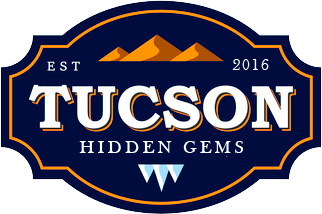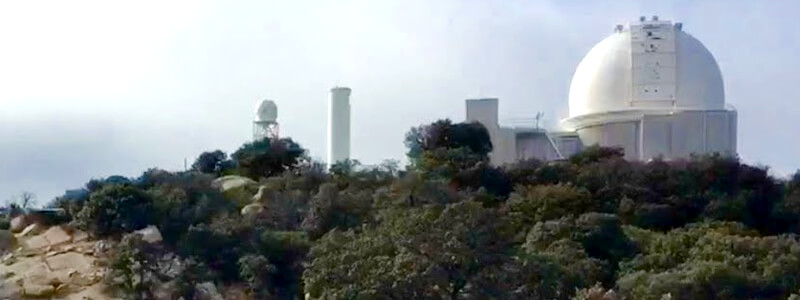Kitt Peak National Observatory – Tucson, Arizona
Tucson is known for its crystal clear skies and excellent astronomy facilities. Kitt Peak National Observatory is located 56 miles southwest of Tucson and supports a diverse collection of observatories both nighttime astronomy as well as daytime study of the sun. In fact, Kitt Peak has the largest collection of optical telescopes in the world with twenty five optical telescopes and two radio telescopes. Eight astronomical research institutions call Kitt Peak their home.
This observatory is part of the National Optical Astronomy Observatory and supports the most diverse collection of astronomical observatories on Earth for nighttime optical and infrared astronomy and daytime study of the sun.
Arizona‘s night skies are the best in the continental United States for viewing and research because of the low humidity, lack of air turbulence, warm temperatures, and controlled urban light pollution.
The University of Arizona holds astronomy camps for teens, adults, and educators at their observatories on Mount Lemmon outside of Tucson, those classes (camps) and a trip to the planetarium/observatory at the University of Arizona’s Flandrau Science Center in Tucson may be a good primer before heading to Kitt Peak. You will get a lot more out of your visit after learning from these two stops.
The Kitt Peak National Observatory is home to twenty-four optical and two radio telescopes representing eight astronomical research institutions.
Mayall telescope
The 4 meter Mayall telescope is a sight to behold standing at eighteen stories tall. This large telescope can be seen from well over fifty miles away. This telescope was one of the largest optical telescopes in the world. The Mayall is used primarily for faint visible light and infrared observations and has a long and significant history.
WIYN Telescope
Kitt Peak’s newest telescope, the WIYN Telescope was dedicated in October of 1994. This is the second largest telescope located here however the building surrounding it is much smaller than its predecessors. This reflects the technology that has progressed over the years. Not only is it technologically improved size-wise, the imagery it produces is super sharp. This is one of the world’s best imaging telescopes ever. The WIYN Telescope is involved with important research such as understanding the origin of gamma ray bursts, the evolution of stars in clusters and viewing supernovae in faraway galaxies.
McMath-Pierce Solar Telescope
You won’t want to miss seeing the McMath-Pierce Solar Telescope, the world’s largest solar instrument. This unique telescope towers 100 feet above with a slanting shaft that angles down 200 feet to the ground. The shaft continues underneath the ground where the sun is then viewed. This instrument is used to study sunspots and sunspot spectra.
Meade Schmidt-Cassegrain telescope
One of the best ways to experience Kitt Peak is to visit at night and view the heavens through the 16-inch Meade Schmidt-Cassegrain telescope and the 20-inch RC Optical systems. The nightly viewing takes place every night most of the year. During the monsoon season (July 15 to August 31) night time viewing is closed. Up to 36 participants are encouraged to experience astronomy as it should be experienced, at night when the stars are out. You’ll view planets, other galaxies and more like you’ve never seen them before. Night viewing costs $39 with discounts for seniors, students and military and due to limited space, reservations are required.
Visiting Kitt Peak Observatory
Visiting Kitt Peak Observatory is a favorite among tourists and locals alike The Visitor Center is open to the public daily from 9 – 3:45 except Thanksgiving, Christmas, and New Years’ day. Guided tours are offered daily at 10 am, 11:30 am and 1:30 pm and group tours are available by appointment. You can stargaze at Kitt Peak with their Nightly Observing Programs. You will observe everything from planets to distant galaxies using the 20″ Ritchey-Chretien, the 16″ Ritchey-Chretien, and their 16t” Meade Schmidt-Cassegrain telescopes. This program is offered to a small group of participants every night of the week (closed from July 15 to September 1 for monsoon season.)
A $2 donation is requested to gain admission to the observatory visitor’s center while guided tours cost from $2 to $6.50. Guided tours take you to either the world’s largest solar telescope (at 10:00 AM), the 2.1 meter telescope (at 11:30 AM) or the 4 meter Mayall telescope (at 1:00 PM). These tours last about an hour to an hour and a half and are led by trained docents who will share the history and interesting facts about the telescopes and Kitt Peak Observatory.
Call 520-318-8726 for reservations. Since this program is so popular it is suggested that you call for reservations 2 to 4 weeks prior to your visit.
Rate Information: Adults $41; Seniors (62 and over) $36; Students (elementary to college) $36; Military (with current ID) $36.
Nightly Observing Program Information
Please arrive 60 to 75 minutes before sunset and check into the Visitor Center (exact time will be given when your reservations are made). Explore the displays and exhibits and then you’ll be served a light meal and experience an introduction to astronomy and the National Observatory. At that time you will head to the overlook point and observe the sun setting over the Tohono O’odham Reservation.
There will be a brief talk about the distances between objects in our universe, you will learn how to use a planisphere to find stars and constellations in the sky. You will then be given a pair of binoculars to use before stepping outside and identifying constellations, stars, and many other interesting objects.
Finally, you will gather in one of the Visitor Centers domes to observe the heavens in all their glory through one of the reflecting telescopes. You will see highlights of the particular time of years like planets, multiple star systems, planetary nebulae, star clusters, and galaxies. You will learn about these objects as you view them and find out what a light year really means. You will have a QA session all during the adventure so ask questions when you have them.
The program runs for 3 to 3.5 hours after sunset. It is something you will remember for a lifetime!
Directions: From Tucson, find Ajo Way (Hwy 86) and head west. Pass Ryan Airfield and Three Points. About 40 Miles from Tucson turn left onto Hwy 386 (signs will say Kitt Peak).
Drive 12 miles up the mountain, until you see a “giant concrete donut” with a mural painted on it. Turn left and park.
The grounds are closed after 4 pm so walk straight to the Visitor Center.
It often gets cold on the mountain, so bring warm clothing, seriously, you will need them.
Kitt Peak is located 6875 feet above sea level so temperatures are drastically different than on the desert floor. Dress warmly and bring hats and gloves for nighttime viewing. You may even want to bring a blanket at night because much of the evening is spent outdoors or in an unheated observatory. Also visit the Lowell Observatory located in Flagstaff in Northern Arizona.
Special events, workshops, and classes are also held regularly at Kitt Peak Observatory.
Directions.
Kitt Peak Observatory is about 56 miles southwest of Tucson off State Route 86.
Take I-10 to I-19 South.
Within 1 mile is the Ajo Way/Hwy 86 exit (Exit 99).
Take this exit West.
Continue past Ryan Airfield and Three Points until reaching Junction 386 (the Kitt Peak turnoff) where you’ll turn left onto 386.
The Kitt Peak Visitor Center is located 12 miles further at the summit.

